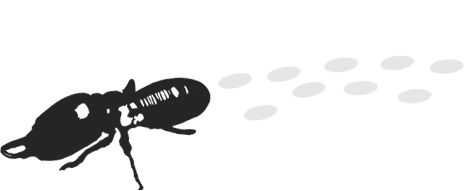Interesting & Some Little Known Termite Facts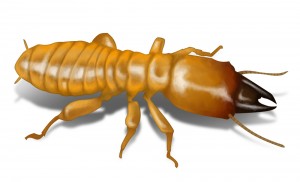
- Termites have been around for more than 240 million years. They adapt to ever changing environments. Termites are nature’s way to break down wood and return it to the soil.
- Genetic research has determined that termites are actually related to roaches.
- Termites can’t smell, taste or see. So how do they know your house is a tasty treat? Termites choose their food based on the vibrations wood makes as they bite into it. As termites grip and pull wood fibers, the fibers snap and send a small impulse through the entire structure that they’re eating. Those vibrations return to the termites and let them know what they’re eating.
- Termites cause more damage than tornadoes, hail storms, wind storms, and hurricanes combined and cost Americans an estimated $1 billion each year.
- Termite colonies (called termitaries) can average between 500,000 and one million termites. There can be as many as 13 to 14 subterranean termite colonies per acre.
- There are 288 known species of termite.
- Termites release an estimated 176 billion pounds of “greenhouse gas” per year.
- One in three Florida homes is covered by a contract with a pest-control company. Florida has an estimated 3,800 pest-control companies.
Distinguishing the Difference Between Flying Ants and Termites
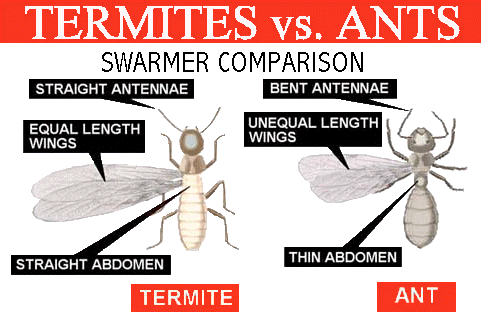
Flying ants have a segmented body (like a regular ant) and have an elbow antennae (curves like a human elbow). Termites have a more broad streamlined body with two sets of wings, both being the same size. Ants have two sets of wings as well, but one set is usually about half the size of the other set. Ant bodies are shaped more like an hourglass.
Termites will have a beaded like antennae whereas ants have a continuous line. See: Termites vs. Ants and How to tell the difference between ants and termites.
A LITTLE TRICK TO FIND OUT WHAT YOU HAVE….If you have a swarming insect problem and don’t know for sure if it’s flying ants or termites, this is a way for YOU to find out. What you do is to take a few LIVE (unsprayed) samples and put them in a jar, then put the jar, closed, of course, on a sunny windowsill.If it’s termites, they’ll die within a few hours,
almost certainly overnight. Termites will often shed their wings, and the next day you’ll see dead termites and shed wings. Check where they were coming from. You should see shed wings there too.If they’re ants, they won’t shed their wings and the ants will still be alive. Ant swarmers are very long-lived and will often live a week or more.
Termite Types
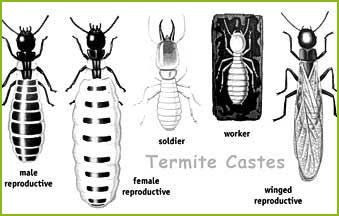 Termites Termites [ pictures of termites ] are small, delicate insects that live inside climate-controlled colonies that are constructed in the soil or in wood. Termite colonies are organized into castes with large “reproductives” and smaller workers and soldiers.
Termites Termites [ pictures of termites ] are small, delicate insects that live inside climate-controlled colonies that are constructed in the soil or in wood. Termite colonies are organized into castes with large “reproductives” and smaller workers and soldiers.
Termites eat wood. They convert wood fiber (cellulose) into sugar. Over time a large termite colony can do extensive damage to structures made of wood. Termites often consume wood from the inside out.
There are many different types of termites. Most occur in tropical, semi-tropical, or hot, arid (desert) climates. Subterranean termites live in soil and attack from the ground up. Drywood termites live in isolated pieces of wood such as attic rafters.
Carpenter ants replace termites in cooler and wetter climates as the dominant structural pest.
Subterranean termites
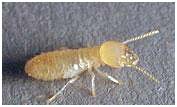 Subterranean termites live in underground colonies on buried wood. When the initial wood supply is depleted the colony may be extended through “shelter tubes” to above ground wood. This is when damage to structures is done. Shelter tubes are made from soil particles and thus are the color and texture of the local soil. The tubes are built on foundation walls, posts, pilings, etc. — anything that spans between soil and wood [ termite entry points drawing ]. Look for termite shelter tubes during annual inspections for insect and water damage and if tubes are found it is an indication that subterranean termites may be active. Other major types of termites such as drywood termites and dampwood termites do not make shelter tubes.
Subterranean termites live in underground colonies on buried wood. When the initial wood supply is depleted the colony may be extended through “shelter tubes” to above ground wood. This is when damage to structures is done. Shelter tubes are made from soil particles and thus are the color and texture of the local soil. The tubes are built on foundation walls, posts, pilings, etc. — anything that spans between soil and wood [ termite entry points drawing ]. Look for termite shelter tubes during annual inspections for insect and water damage and if tubes are found it is an indication that subterranean termites may be active. Other major types of termites such as drywood termites and dampwood termites do not make shelter tubes.
Drywood termites
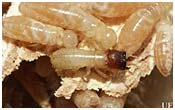
Termite Types do not need contact with soil moisture nor any other water source. As their name suggests, drywood termites occur in dry wood that may be above ground level. They build colonies in structural wood fence and utility posts, furniture, moldings, door and window frames, etc.
Prevention Tips
- Avoid accumulating water near your home’s foundation by diverting away rain water with downspouts.
- Reduce humidity in crawl spaces and attics with proper ventilation.
- Eliminate wood contact with the soil.
Note: Thank you http://www.livingwithbugs.com/ for some of the information above.
Articles of Interest
- 10 Thing Your Exterminator Won’t Tell You – July 21, 2009 – SmartMoney Magazine
- Taking On Termites – Consumer Report – July 17, 2009 – MyFox Tampa Bay
- Video – Termite World; Life in the Undergrowth – BBC – November, 2008
- UF Research Shows Termite Damage Cuts Insulation Values by Nearly 75% – March 26, 2008 – University of Florida News

